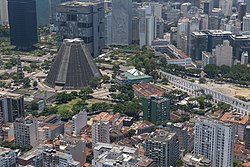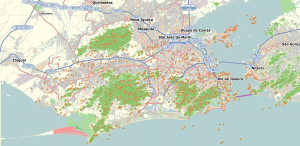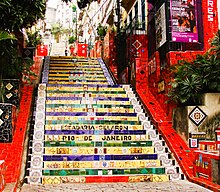This article has multiple issues. Please help improve it or discuss these issues on the talk page. (Learn how and when to remove these messages)
|
| Lapa | |
|---|---|
| Neighborhood | |
 Aerial view of Lapa Aerial view of Lapa | |
  | |
| Coordinates: 22°54′49″S 43°10′54″W / 22.91361°S 43.18167°W / -22.91361; -43.18167 | |
| Country | |
| State | Rio de Janeiro (RJ) |
| Municipality/City | Rio de Janeiro |
| Zone | Centro |
Lapa is a neighborhood in Rio de Janeiro, Brazil. Located in the center of the city, it is famous for its historical monuments and vibrant nightlife.
The neighborhood is home to the Arcos da Lapa, an impressive aqueduct constructed by colonial authorities in the mid-18th century. Another important historical attraction is the Passeio Público, the city's first public park, built in the 1780s.
Since the early 1950s, Lapa has been known for its lively cultural scene, featuring numerous restaurants and bars where Brazilian artists and intellectuals gather. It remains renowned for its venues offering various forms of Brazilian music. The Sala Cecília Meireles, an essential venue for chamber music, is also located in Lapa.
Arcos da Lapa


The neighborhood of Lapa in Rio de Janeiro is known as the "cradle of Bohemian Rio". It is also famous for its architecture, beginning with the Arcos da Lapa (also known as the Carioca Aqueduct), which was originally constructed as an aqueduct during Colonial Brazil and now serves as a viaduct for the cable cars that climb the hill of Santa Teresa.
The Carioca Aqueduct is considered a significant architectural work in old Rio and one of the city's main symbols. The large Roman-style structure is 17.6 meters high, 270 meters long, and features 42 arches that connect the neighborhood of Santa Teresa to Morro de Santo Antônio. Built in 1723 during colonial times, the aqueduct was designed to channel water from the Carioca River through Morro do Desterro to Santa Teresa and Morro de Santo Antônio. It played a crucial role in preventing water shortages in the city, a historically persistent problem. While studies to bring the waters of the Carioca River to the city began in the early seventeenth century, the actual installation of water pipes in Rio de Janeiro did not commence until a century later.
In recent times, the landscape of Lapa has transformed, bringing a wave of cultural vibrancy. The Square of the Brazilian Armed Forces, once a quiet spot next to the arches, has been replaced by the lively Circo Voador. Arches Street, once a serene passage across the aqueduct, is now a vibrant venue. The neighborhood's boundary begins at the south end, where the Road of Glory becomes Rua da Lapa. On the border with Santa Teresa, nestled among its hills, is the culturally rich neighborhood of Fátima.
In an attempt to revive the spirit of the deteriorating residential district, its inhabitants created the movement "I Am From Lapa." They drew inspiration from the famous advertising campaign "I Love New York," which they believed helped revitalize New York City during its decline in the 1970s. With government support and the participation of most shops in Lapa, the "I Am From Lapa" movement spread throughout the area, but it did little to improve the safety of the residential environment.
Lapa enjoys lower population density and less traffic compared to other regions of the city. The neighborhood is home to the headquarters and administrative buildings of many large companies (such as Petrobras and BNDES), as well as numerous high-quality commercial buildings on Chile Avenue (including Ventura I and II). These features have attracted residents from the north, south, and west of Rio de Janeiro who seek to live closer to work and to avoid traffic jams. Newly launched residential projects with comprehensive infrastructure (such as Viva Lapa and Cores da Lapa) have been fully sold, reflecting a high demand for housing in a neighborhood perceived to offer a high standard of living.
Culture


The neighborhood offers a melting pot of diverse urban tribes, an attractive quality for those who love to go out and keep the night alive. Since the 1950s, Lapa has been referred to as "Montmartre Carioca." Intellectuals, artists, politicians, and especially the people of Rio have come together to celebrate samba, forró, MPB (música popular brasileira), choro, and, more recently, electronic music and rock.
The major thoroughfares, Mem de Sá, Rua do Riachuelo, and Lavradio, feature attractions such as the Sala Cecília Meireles, which is considered one of the best concert venues for chamber music in Rio.
The Public Promenade, the National School of Music, the Church of Our Lady of Lapa do Desterro, and the Escadaria Selarón stand as monuments for tourists who want to explore the architecture of old Rio.
Music
| This section needs to be updated. Please help update this article to reflect recent events or newly available information. (June 2024) |
Popular nightlife attractions include the famous Asa Branca, a key venue for forró; Bar Semente, where artists such as Teresa Cristina and the group Casuarina have performed; Ernesto; Sacrilégio Café Cultural; Rio Scenarium; and Carioca da Gema, where samba reigns supreme. The venue Lapa 40 Graus, which recently opened on Rua do Riachuelo next to the traditional Democratic Club, offers space for dancing samba, choro, and gafieira. Those who prefer electronic music and rock concerts can enjoy Progress and Casting Flying Circus, which opened in 2004. There are also numerous bars and venues catering to all tastes.
References
- "Walking through Rio – A tale of many cities". World Footprints. Retrieved 7 July 2024.